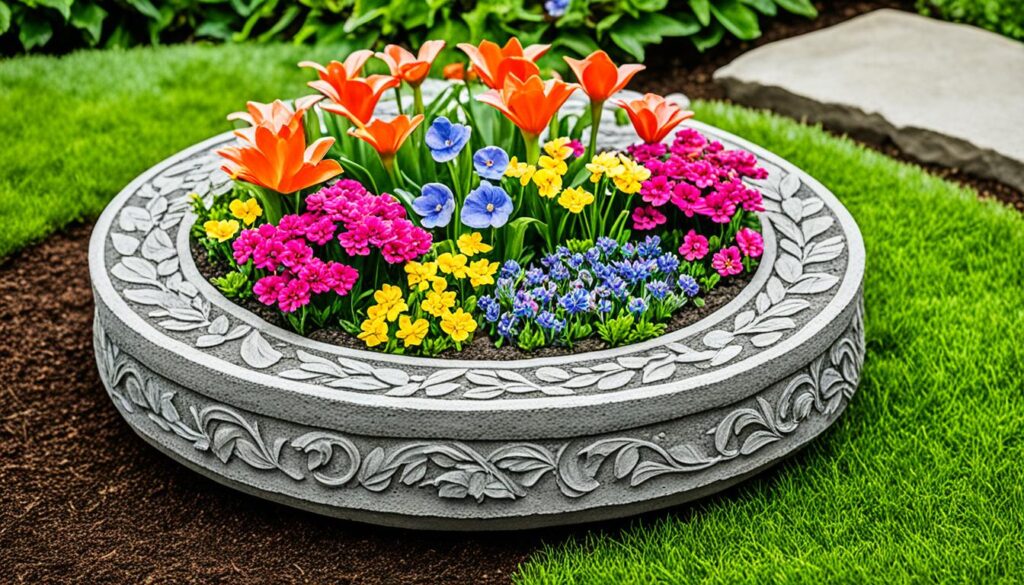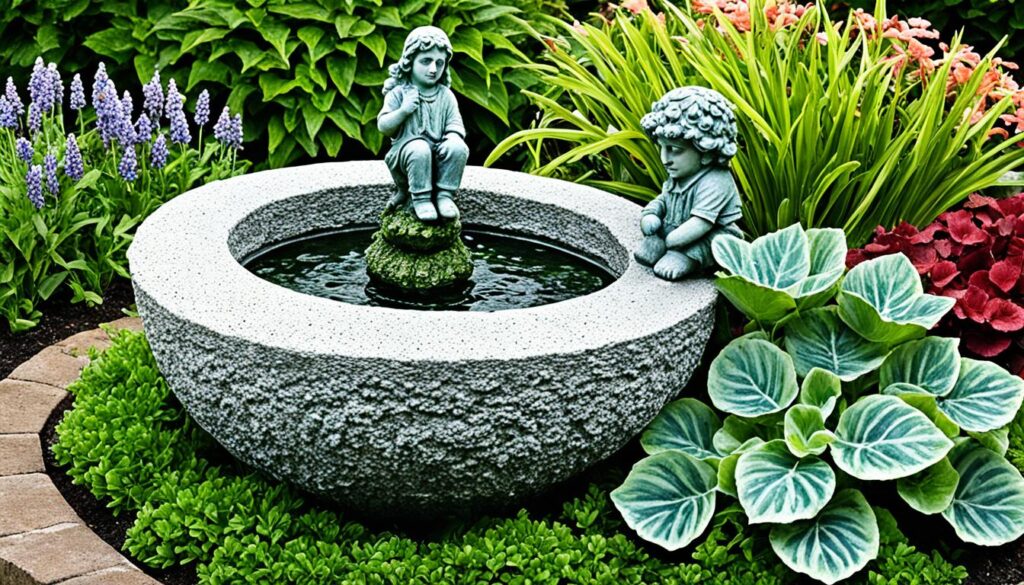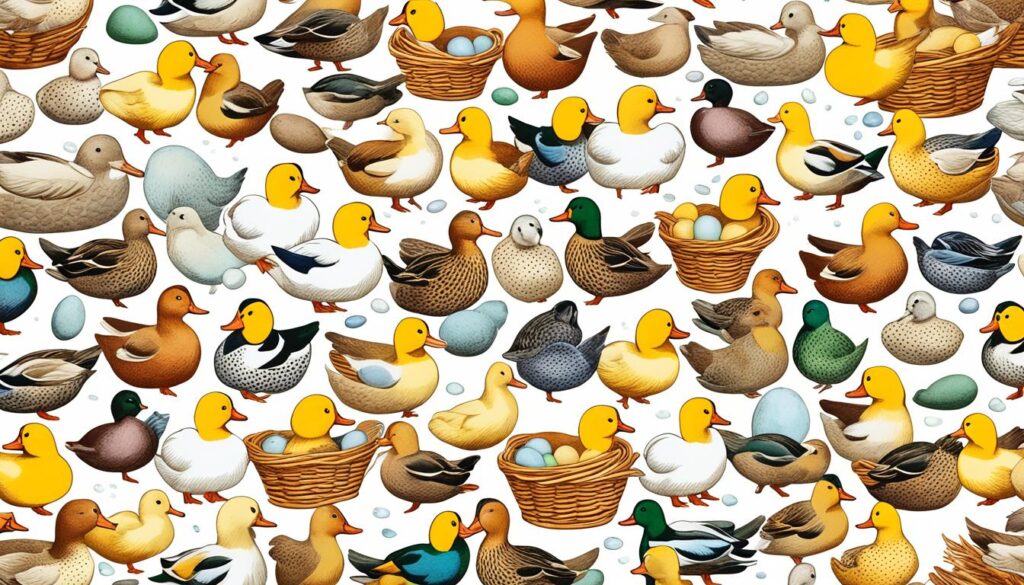Did you know over 80% of garden lovers see durable, weatherproof statues as key for their outdoor areas? With the right cement, you can make beautiful, lasting garden ornaments. These will make your yard or patio look amazing. In this guide, we’ll look at the best cements for your DIY projects.
Key Takeaways
- Discover the essential cement types for creating weather-resistant garden sculptures
- Learn the advantages of using durable cement blends for outdoor ornaments
- Understand the proper cement ratios and techniques for constructing long-lasting yard art
- Find expert advice on selecting the right waterproof cement mixes for your garden decor projects
- Explore the versatility of concrete and cast stone for creating unique garden sculptures
Introduction to Garden Ornaments
Garden ornaments and outdoor sculptures can make any outdoor space more charming and unique. They come in many shapes, sizes, and materials. It’s important to know about the materials like resin, metal, and natural stone used for garden statues. This knowledge helps in choosing the right ornaments for your yard or patio.
The Charm of Outdoor Sculptures
Outdoor sculptures can turn a garden or patio into a captivating place. They can be whimsical, playful, or serene. This lets homeowners show off their style and taste. Whether you like classical or modern designs, garden ornaments can make your outdoor space special.
Materials Used for Garden Statues
There are many materials for garden decor to choose from, each with its own benefits and things to consider. Some common types of garden ornaments include:
- Plastic: Affordable but may not last long in harsh weather
- Resin: Stronger than plastic but can fade, warp, or crack
- Wood: Looks nice but needs regular care to prevent damage
- Metal: Lasts a long time and can get a nice look over time, with popular choices like aluminum, copper, brass, bronze, stainless steel, and lead
- Ceramic and Glass: Can break if they get wet and freeze
- Concrete: Affordable and comes in many sizes and shapes, but can break in changing weather
- Natural Stone: Includes limestone, marble, granite, and sandstone, lasts a long time and looks great in gardens
- Cast Stone: Made from finely ground concrete, they’re strong, easy to care for, and less likely to crack, making them a smart choice for decorating your home and garden
Choosing the right materials for your garden ornaments depends on what you like, your budget, and your outdoor space’s conditions.
Resin Garden Statues
Resin garden statues are a top pick for making your outdoor space better. They are made from strong polyresin. This material is great for being molded into detailed sculptures. It makes resin garden statues and polyresin sculptures that look real and add beauty to your garden or patio.
Advantages of Polyresin for Outdoor Sculptures
Polyresin is great for outdoor sculptures because it’s very durable. It’s light but strong and can handle the weather, sun, and other outdoor challenges. Plus, it’s easy to take care of, so your resin garden statues will look good for a long time.
Types of Resin for Garden Decor
- Epoxy resin: It’s strong and clear, making it perfect for detailed polyresin sculptures that can be outside.
- Polyurethane resin: This resin is great for outdoor use because it resists weather and sunlight well. It’s perfect for types of resin for outdoor decor that are outside a lot.
- Acrylic resin: It’s light and easy to work with, making it a good choice for advantages of resin for garden art. You can make detailed designs that look great outside.
No matter the resin type, resin garden statues are a great mix of art, strength, and easy care. They’re becoming more popular with people who love gardens and homes.
Metal Garden Sculptures
Metal is a top choice for outdoor art because it’s both beautiful and lasts long. You can pick from bronze’s elegance or steel’s rustic look. These metal options for outdoor art let you find the perfect piece for your garden.
Popular Metal Options for Yard Art
Several metals are great for metal garden sculptures because they look good and last long:
- Bronze – It has a warm look and gets a nice patina over time. Bronze is great for outdoor art because it doesn’t rust easily.
- Copper – Copper looks beautiful with its reddish-brown color and turns green with age. It’s also resistant to rust, making it a good choice for garden art.
- Steel – Steel is strong and can be finished in many ways. With a powder coat, steel sculptures can last outside and add a modern look to your garden.
Choosing the right metal is important, but taking care of your metal garden sculptures is key to keeping them looking great. Use protective coatings, clean off rust, and bring them inside when it’s very cold or windy. This will help your outdoor art last a long time.
| Metal Type | Aesthetic Appeal | Durability | Maintenance |
|---|---|---|---|
| Bronze | Rich, warm tones; develops patina | Highly resistant to weathering | Minimal maintenance required |
| Copper | Striking reddish-brown; develops green patina | Naturally resistant to corrosion | Periodic polishing may be needed |
| Steel | Contemporary, industrial look | Sturdy and durable with powder coating | Requires regular cleaning and rust prevention |
“Metal garden sculptures offer a timeless elegance that can transform any outdoor space into a visually captivating oasis.”
Natural Stone Garden Statues
Looking for something that lasts and looks great? Natural stone garden statues are a top pick. Marble, granite, and sandstone are favorites for their beauty and strength. They add elegance to your garden and can handle the outdoors well.
Marble and Granite for Durable Sculptures
Marble is a top choice for garden statues because of its beauty and toughness. It keeps its shine for many years. Granite is also a great pick for statues. It’s very strong and can stand up to the weather.
Sandstone for Natural Garden Aesthetics
Sandstone brings a natural look to your garden. Its unique texture makes your statues blend in perfectly. These natural stone garden statues add beauty and balance to your garden.
| Material | Durability | Aesthetic |
|---|---|---|
| Marble | Excellent | Elegant, Polished |
| Granite | Exceptional | Sturdy, Weather-Resistant |
| Sandstone | Durable | Natural, Earthy |
Choosing marble sculptures, granite sculptures, or sandstone garden art means your garden will look amazing for years. These durable stone options for outdoor decor will make your garden stand out.
what cement to use for garden ornaments
Choosing the right cement is key for making garden ornaments last. You need to think about weather resistance, strength, and how easy it is to work with. We’ll look at different cements and help you pick the best one for your garden art.
A good mix for garden ornaments is a 3:1 ratio of ballast to cement. Ballast is a mix of stone and sand that makes the concrete stronger. Using 10mm ballast gives you a strong and solid result.
It’s important to thoroughly mix the dry ingredients before adding water. The mix should be runny and creamy, so it flows well into the mold’s details without air holes. To get rid of air bubbles, vibrate the concrete in the mold for about 20 seconds.
| Cement Ratio | Ballast Size | Consistency |
|---|---|---|
| 3 parts ballast to 1 part cement | 10mm | Runny and creamy |
If you want a paler, whiter color for your ornaments, try Ivory Cement and White Sand. This mix gives a nice look that fits well with the outdoors.
Getting the mix right is key to great results. Don’t overmix to avoid air bubbles. Tapping the mold with the mix helps settle it and gets rid of air pockets.
By using the right cement and following these tips, you can make garden ornaments that last and look great. They’ll add beauty to your outdoor space for years.
Concrete and Cast Stone Sculptures
Concrete and cast stone are top choices for garden ornaments. Each has its own set of pros and cons. Knowing these can help you pick the right material for your outdoor sculptures.
Pros and Cons of Concrete Garden Statues
Concrete is strong and easy on the wallet for concrete garden sculptures. It can handle the weather and support your outdoor art well. But, it can crack and weather over time, especially in places with big temperature changes. Also, it might not have the fine details that natural stone or cast stone do.
| Pros of Concrete Garden Sculptures | Cons of Concrete Garden Sculptures |
|---|---|
|
|
Cast stone sculptures are a special kind of concrete mix. They look more like stone and are very durable. Cast stone is great for places that freeze and thaw a lot. Plus, you can choose from many colors and finishes to match your garden.

“Cast stone can mimic materials such as terra cotta, slate, sandstone, and more. Manufacturers can offer custom coloring for cast stone products.”
Cast stone sculptures cost more than concrete ones. But, they are a good choice if you want quality and don’t want to spend a lot on upkeep.
Maintaining Garden Sculptures
Keeping your garden sculptures looking great is key to their beauty and long life. Whether they’re made of stone, metal, resin, or concrete, cleaning and care are vital. This keeps your yard art looking good and makes it a highlight of your garden.
Cleaning and Protecting Outdoor Statues
It’s a good idea to clean your garden sculptures every time you mow your lawn. This stops dirt, moss, and mildew from building up. The cleaning method depends on the statue’s material:
- Stone and concrete statues can be cleaned with mild soap and water, then rinsed well.
- Metal sculptures, like bronze or iron, might need sanding or wire brushing to remove rust and shine.
- Resin and wood statues should be cleaned with a soft cloth and a gentle cleaner to avoid damage.
If you see mold, mildew, or discoloration, a mix of water and mild detergent can help. Make sure to rinse the statues well and let them dry before applying a sealant or wax. This protects your outdoor art from the weather and keeps it looking good for a long time.
| Material | Cleaning Technique | Protective Measures |
|---|---|---|
| Stone and Concrete | Mild soap and water | Sealants or wax |
| Metal (Bronze, Iron) | Sanding, wire brushing | Wax or clear coat |
| Resin and Wood | Gentle, non-abrasive cleaner | Sealants or protective finishes |
By following these easy cleaning and care tips, your garden sculptures will keep looking great. They’ll continue to add beauty to your outdoor space for many years.
Selecting the Right Garden Ornament
Finding the perfect garden ornament is fun and lets you add your personal touch to your outdoor area. Whether you’re choosing garden ornaments, thinking about factors to consider for yard art, or picking how to select outdoor sculptures, this guide will guide you. It will help you make great choices for your garden’s best practices for garden decor.
The material of your garden ornaments is key. You can pick from strong cast stone, weather-proof bronze, or light and cheap resin. Think about the look you want, and how your garden’s weather and conditions will be.
| Material | Durability | Maintenance | Cost |
|---|---|---|---|
| Cast Stone | High | Low | Moderate |
| Bronze | Exceptional | Moderate | High |
| Resin | Good | Low | Low |
Think about the size and where you’ll put your garden ornament too. Make sure it fits well with your outdoor space and doesn’t take over. Grouping sculptures can make a big impact, or a single statue can be a beautiful focus.
“The right garden ornament can transform your outdoor space, adding a touch of elegance, whimsy, or natural beauty.”
Choosing the right garden ornament is a personal journey. It lets you show off your style and love for nature. By thinking about the material, size, and where to put it, you can make a garden that looks great and shows off your taste.

Conclusion
This guide has covered the best cement for garden ornaments and durable outdoor sculptures. We’ve looked at materials like resin, metal, natural stone, and concrete. You now know how to pick the right cement for your garden art.
Choosing the right cement, like Cement-All by Rapid Set or Concrete Mix, is key. Also, preparing your workspace, mixing concrete, and finishing it right is important. This way, your garden ornaments and sculptures will last for many years.
Think about color, texture, and upkeep to get the look and durability you want. Whether it’s a birdbath, a statue, or a bench, this guide has given you the knowledge to make it happen. With the right materials and methods, your garden art will be beautiful and stand up to the weather. Let your creativity shine and make your outdoor space a beautiful oasis.
FAQ
What cement should I use for creating garden ornaments?
Choosing the right cement is key for durable garden ornaments. Look for strength, weatherproofing, and workability. Concrete, cast stone, and specialized blends are good options.
How do I mix concrete for garden sculptures?
A strong mix for garden sculptures needs the right cement-to-aggregate ratio. Use 1 part cement to 2-3 parts sand and gravel. Measure ingredients carefully and cure the concrete well for lasting results.
What is the best cement for outdoor decorations?
For outdoor decorations, choose a cement that’s weather-resistant and durable. Portland cement-based mixes, like those for concrete or cast stone, are great. They offer strength, water resistance, and can be shaped into detailed designs.
How can I make my garden sculptures weatherproof?
Use a cement made for outdoors to make sculptures weatherproof. These cements have additives for better durability and weather resistance. Sealing the sculptures after finishing also helps protect them from the elements.
What cement mix is best for durable garden statues?
For lasting garden statues, pick a strong, weather-resistant cement mix. Concrete or cast stone mixes with a high cement ratio are good choices. They can be molded into detailed, durable garden art.
Which cement types are suitable for exterior ornaments?
For outdoor ornaments, choose cements made for the elements. Portland cement-based mixes, like for concrete or cast stone, are great. They’re strong, water-resistant, and can be shaped into various designs.
How do I choose a long-lasting cement for garden decor?
For garden decor, pick cements made for outdoors. Look for additives like polymers for better durability. Concrete and cast stone mixes are popular for lasting garden art.
What cement formulas are best for outdoor ornaments?
For outdoor ornaments, choose a cement blend for strength and weather resistance. Concrete and cast stone mixes work well for detailed designs. The right cement-to-aggregate ratio is important for garden art.
How do I determine the right cement ratios for garden figurines?
The cement ratio for garden figurines depends on strength and workability needed. A mix of 1 part cement to 2-3 parts sand and gravel is common. For detailed figurines, more cement can be used for strength and design.
What waterproof cement mixes are best for garden art?
For garden art that faces the elements, waterproof cement mixes are best. Look for blends with polymers or sealants for extra protection. Cast stone and outdoor concrete formulas are good choices for weatherproofing your sculptures and ornaments.




Thank you for your sharing. I am worried that I lack creative ideas. It is your article that makes me full of hope. Thank you. But, I have a question, can you help me?
Your point of view caught my eye and was very interesting. Thanks. I have a question for you.